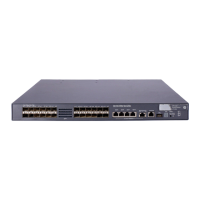27
To do… Use the command… Remarks
4. Configure the destination
address of probe packets.
destination ip ip-address
Required.
By default, no destination IP
address is configured.
5. Configure the source IP
address of probe packets.
source ip ip-address
Optional.
By default, no source IP address is
specified.
The source IP address must be the
IP address of a local interface.
The local interface must be up;
otherwise, no probe packets can
be sent out.
6. Configure optional
parameters.
See “Configuring optional
parameters for an NQA test
group”
Optional.
Configuring the collaboration function
Collaboration is implemented by establishing reaction entries to monitor the detection results of a test
group. If the number of consecutive probe failures reaches the threshold, the configured action is
triggered.
To configure the collaboration function:
To do… Use the command… Remarks
1. Enter system view.
system-view —
2. Enter NQA test group view.
nqa entry admin-name operation-
tag
—
3. Enter test type view of the test
group.
type { dhcp | dlsw | dns | ftp |
http | icmp-echo | snmp | tcp |
udp-echo }
The collaboration function is not
supported in UDP jitter and voice
tests.
4. Configure a reaction entry.
reaction item-number checked-
element probe-fail threshold-type
consecutive consecutive-
occurrences action-type trigger-
only
Required.
Not created by default.
You cannot modify the content of
an existing reaction entry.
5. Exit to system view.
quit —
6. Configure a track entry and
associate it with the reaction
entry of the NQA test group.
track entry-number nqa entry
admin-name operation-tag
reaction item-number
Required.
Not created by default.

